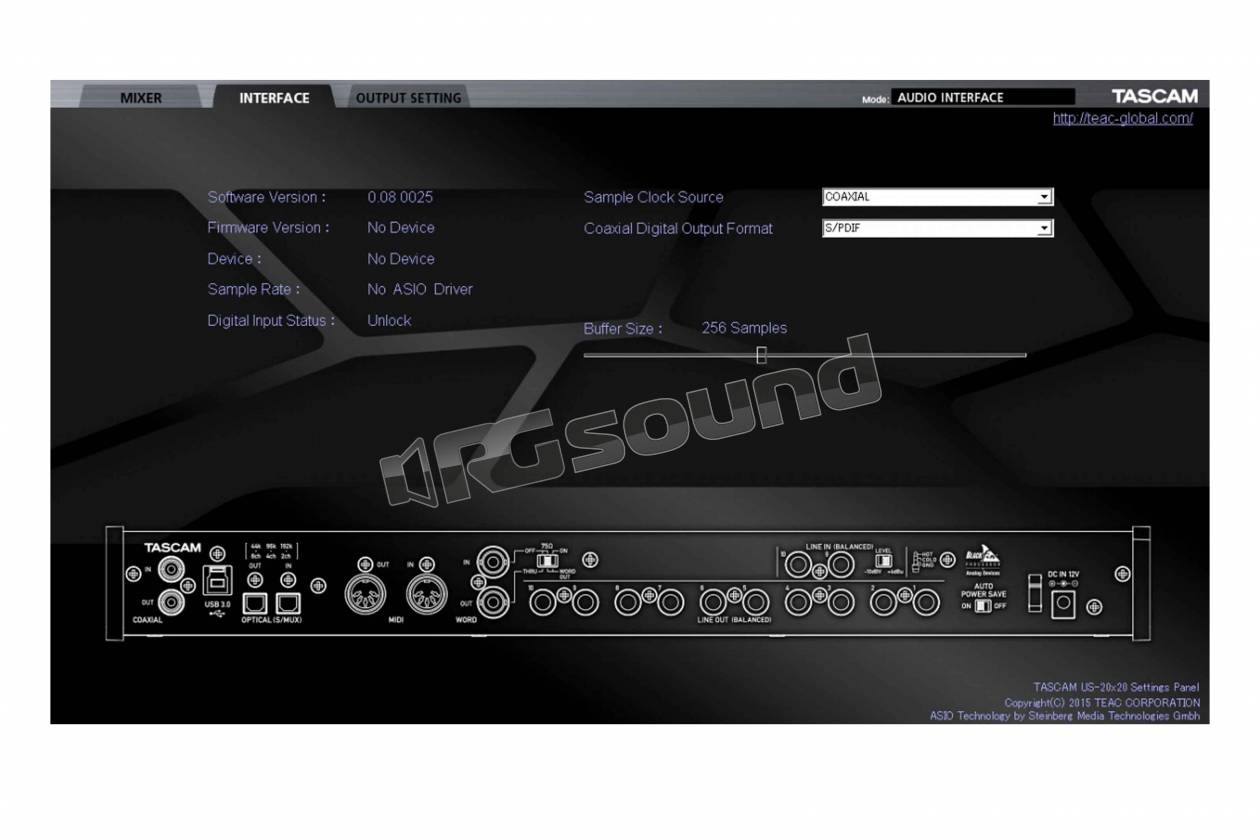Ti invitiamo a visitare il nostro shop per scoprire tutte le novità!
Clicca qui!

il tuo prezzo: € 475,00
Prezzo riferito a singolo pezzo (IVA inclusa)
TASCAM US-20x20 interfaccia audio USB 20 ingressi, 20 uscite (totali). Contenitore in alluminio e connettori di ingresso COMBO E JACK per microfoni e linea. Non necessita di Driver per funzionare su computer (compatibile ASIO e Core Audio).10 uscite audio analogiche e 2 uscite cuffia separate.
Progettata per l’uso in studi di registrazione professionali e home studios, questa interfaccia puo’ registrare audio fino a 192 kHz/24bit e utilizza USB 3.0 come standard di trasmissione dati. Inoltre con la modalità Mic Preamp e modalità Mixer, diventa uno strumento molto versatile oltre ad essere un’interfaccia multi-canale.
I preamplificatori microfonici sono essenziali per ottenere la massima qualità audio. Gli otto preamp Tascam Ultra-HDDA hanno un rumore di ingresso equivalente (EIN) di -125 dBu e 20 dB di headroom sugli ingressi microfonici e di linea che permettono di gestire facilmente forti pressioni sonore generate da percussioni e strumenti a fiato.
Utilizzando un processore Blackfin ad alte prestazioni, l’US-20x20 offre un avanzato mixer DSP con controlli EQ, compressore e riverbero per ogni canale. Il processore eccelle non solo sulle dinamiche e gli effetti, ma consente la trasmissione multicanale tramite USB 3.0.
La possibilita’ di cambiare modalita’ di utilizzo consente alla US-20x20 di funzionare come preamplificatore microfonico indipendente, come interfaccia audio, oppure come un mixer per applicazioni live.
La completa connettività ai vari tipi di apparecchiature audio si ottiene utilizzando gli ingressi analogici e le uscite, ingresso e uscita digitale tramite connettori coassiali e ottici, MIDI e Word Clock mediante connettori BNC.
Lo stile accattivante e razionale della US-20x20, ne rendono particolarmente semplice l’inserimento nella propria postazione di registrazione. Nella confezione è incluso un adattatore per montaggio a rack.
TASCAM US-20x20 caratteristiche tecniche
| General | |
| Sampling frequencies | USB 3.0: 44.1/48/88.2/96/176.4/192 kHz USB 2.0: 44.1/48/88.2/96 kHz |
| Quantization bit depth | 16/24-bit |
| Analogue inputs | |
| Mic inputs (balanced, IN1–IN8) | XLR-3-31 equivalent (1: GND, 2: HOT, 3: COLD) |
| Input impedance | 2.4 kΩ |
| Nominal input level (gain knob at MAX) | −68 dBu (0.0003 Vrms) |
| Nominal input level (gain knob at MIN) | −12 dBu (0.195 Vrms) |
| Maximum input level | +8 dBu (1.947 Vrms) |
| Gain range | 56 dB |
| Instrument inputs (unbalanced, IN1–IN2) | 6.3mm (1/4") standard TS jacks (Tip: HOT, Sleeve: GND) |
| Input impedance | 1 MΩ or more |
| Nominal input level (gain knob at MAX) | −68 dBV (0.0004 Vrms) |
| Nominal input level (gain knob at MIN) | −12 dBV (0.251 Vrms) |
| Maximum input level | +8 dBV (2.512 Vrms) |
| Gain range | 56 dB |
| Line inputs (balanced, IN1–IN8) | 6.3mm (1/4") standard TRS jacks (Tip: HOT, Ring: COLD, Sleeve: GND) |
| Input impedance | 10 kΩ |
| Nominal input level (gain knob at MAX) | −52 dBu (0.0019 Vrms) |
| Nominal input level (gain knob at MIN) | +4 dBu (1.228 Vrms) |
| Maximum input level | +24 dBu (12.282 Vrms) |
| Gain range | 56 dB |
| Line inputs (unbalanced, LINE IN 9–10, LEVEL switch set to −10dBV) | 6.3mm (1/4") standard TS jacks (Tip: HOT, Sleeve: GND) |
| Input impedance | 10 kΩ |
| Nominal input level | −10 dBV (0.3162 Vrms) |
| Maximum input level | +10 dBV (3.162 Vrms) |
| Line inputs (balanced, LINE IN 9–10, LEVEL switch set to +4dBu) | 6.3mm (1/4") standard TRS jacks (Tip: HOT, Ring: COLD, Sleeve: GND) |
| Input impedance | 10 kΩ |
| Nominal input level | +4 dBu (1.228 Vrms) |
| Maximum input level | +24 dBu (12.282 Vrms) |
| Analogue outputs | |
| Line outputs (balanced, LINE OUT 1–10) | 6.3mm (1/4") standard TRS jacks (Tip: HOT, Ring: COLD, Sleeve: GND) |
| Output impedance | 100 Ω |
| Nominal output level | +4 dBu (1.228 Vrms) |
| Maximum output level | +24 dBu (12.277 Vrms) |
| Headphones outputs (PHONES 1/2) | 6.3mm (1/4") standard stereo jacks |
| Maximum output power | 70mW + 70mW (THD+N 0.1% or less, into 32 Ω load) |
| Frequency response (Input to PHONES 1/2 output) | |
| At 44.1 kHz and 48 kHz | 20 Hz – 20 kHz, ±1.0 dB (JEITA) |
| At 88.2 kHz and 96 kHz | 20 Hz – 40 kHz, ±2.0 dB (JEITA) |
| At 176.4 kHz and 192 kHz | 20 Hz – 80 kHz, ±5.0 dB (JEITA) |
| Digital audio inputs and outputs | |
| COAXIAL IN | RCA pin jacks |
| Signal format | IEC 60958-3 (S/PDIF) |
| Input impedance | 75 Ω |
| Input level | 0.5 Vpp/75 Ω |
| COAXIAL OUT | RCA pin jacks |
| Signal formats | IEC 60958-3 (S/PDIF) or IEC 60958-4 (AES/EBU), selectable on the Settings Panel |
| Output impedance | 75 Ω |
| Output level | 0.5 Vpp/75 Ω |
| OPTICAL (S/MUX) IN/OUT | OPTICAL (JEITA RC-5720C) |
| Signal format | Multi-channel optical format (supports S/MUX at 88.2 kHz, 96 kHz, 176.4 kHz or 192 kHz) |
| Other inputs and outputs | |
| USB | USB 3.0 B type |
| Transfer rate | USB 3.0 Super Speed (5 GBit/s) |
| MIDI IN | 5-pin DIN |
| Format | standard MIDI |
| MIDI OUT | 5-pin DIN |
| Format | standard MIDI |
| WORD IN | BNC (Termination on/off switch included) |
| Input voltage | 2.0Vpp - 5.0Vpp |
| Input impedance | 75 Ω ±10 % |
| Permitted frequency deviation during external synchronization | ±100 ppm |
| WORD OUT | BNC (OUT/THRU switch included) |
| Output voltage | 2.0 Vpp (into 75Ω load) |
| Output impedance | 75 Ω ±10 % |
| Sampling frequencies | 44.1 kHz, 48 kHz, 88.2 kHz, 96 kHz, 176.4 kHz, 192 kHz |
| Audio performance | |
| Mic amp EIN (equivalent input noise) | −125 dBu or lower |
| Frequency response (Input to LINE OUT (BALANCED)) | |
| At 44.1/48 kHz | 20 Hz – 20 kHz, ±0.5 dB (JEITA) |
| At 88.2/96 kHz | 20 Hz – 40 kHz, ±0.5 dB (JEITA) |
| At 176.4/192 kHz | 20 Hz – 80 kHz, ± 5 dB (JEITA) |
| S/N ratio | 104 dB or higher (MIC/LINE IN to LINE OUT, gain knob at MIN, JEITA) |
| Distortion | 0.004 % or less (MIC/LINE IN to LINE OUT, 1 kHz sine wave, at nominal input level and maximum output level) |
| Crosstalk | 100 dB or more (MIC/LINE IN to LINE OUT, 1 kHz) |
| Computer system requirements | |
| Important note: Operation of this unit was confirmed using standard computers that meet the above requirements. This does not guarantee operation with all computers that meet the above requirements. Even computers that meet the same system requirements might have processing capabilities that differ according to their settings and other operating conditions | |
| Windows | |
| Supported operating system, USB 3.0 | Windows 10 32/64-bit |
| Supported operating systems, USB 2.0 | Windows 8 (including 8.1) 32/64-bit Windows 7 32/64-bit SP1 or later (Windows Vista and Windows XP are not supported) |
| Computer hardware requirements | Windows computer with a USB 3.0 or USB 2.0 port |
| CPU/processor speed | 2 GHz or faster dual core processor (x86) |
| Memory | 2 GB or more |
| Screen resolution | 1280×800 pixels or more |
| Mac OS X | |
| Supported operating system, USB 3.0 | OS X El Capitan (10.11.2 or later) |
| Supported operating systems, USB 2.0 | OS X Yosemite (10.10.1 or later) OS X Mavericks (10.9.5) OS X Mountain Lion (10.8.5) |
| Computer hardware requirements | Mac with a USB 3.0 or USB 2.0 port |
| CPU/processor speed | 2 GHz or faster dual core processor |
| Memory | 2 GB or more |
| Screen resolution | 1280×800 pixels or more |
| Apple iOS devices | |
| Operating system | iOS 7 or later |
| Supported audio drivers | Windows: USB Audio Class 2.0, ASIO 2.0, WDM (MME), MIDI Mac: Core Audio, Core MIDI |
| Power supply and other specifications | |
| Power supply | DC12V AC adapter (GPE248-120200-Z) |
| Power consumption | 20 W |
| Dimensions (W × H × D) | 445 mm × 59 mm × 222 mm (with standard frame attached) 483 mm × 44 mm × 222 mm (with rack mount adapters attached) |
| Weight | 2.7 kg |
| Permissible operating temperature range | 5–35 °C |























